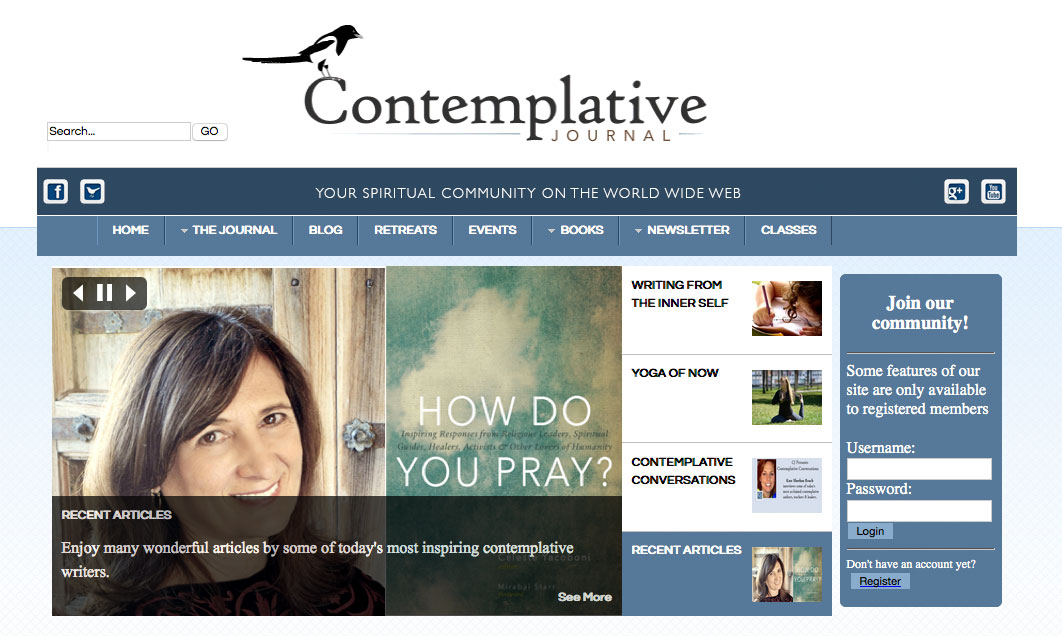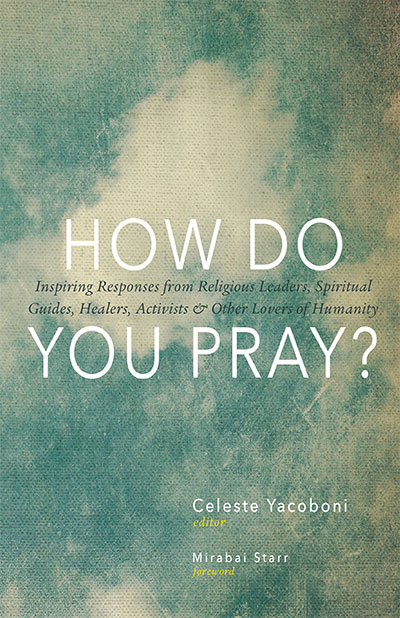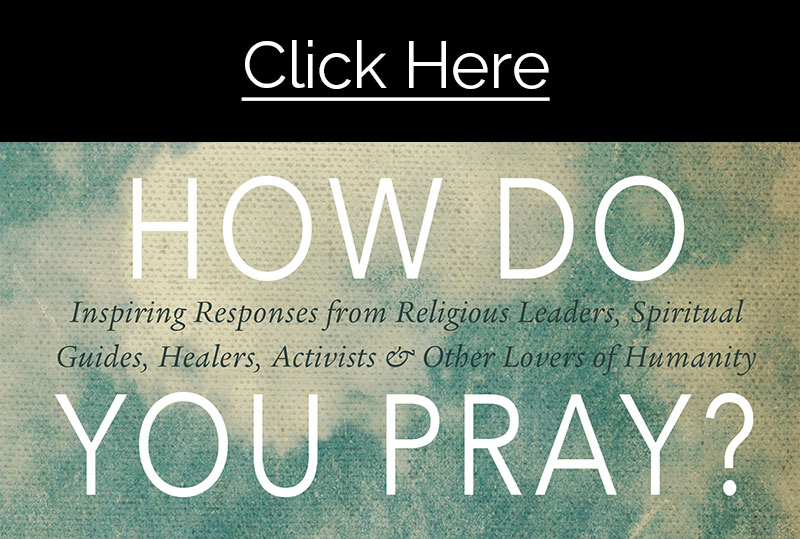Celeste contributed the following article to the Contemplative Journal at http://contemplativejournal.com.

In the autumn of 2008 I was blasted with a vision that would change my life forever.
Four simple words stopped the activity of my mind and invited me to stillness. Like a koan they invoked reflection like a mirror to the soul.
I awoke to illumination in the darkness of early morning. It was an intensity that lit up the room. Yes, it was a voice. I heard the words “How do you pray?”
And the voice continued:
“How do you dance in ecstasy, bare your soul to the divine, bow in gratitude, cry out for guidance, and merge with nature?
Do you pray an hour a week at a designated place of worship or do you take your prayers out to the streets?
Do you pray like your parents, culture, or tribe or did you develop another way?
Do you pray to God or do you have another special name, or no name at all?
Is it a monolog or a conversation, or neither?”
The words became visual, and I saw the prayers of every religion and spiritual practice being said, expressed, and felt. I saw the whirling dervishes, the davening Jews, the prostrating Muslims, the meditating Buddhists, the knelling Christians, the adoring Hindus. I saw the dances of the indigenous people all over the world as their feet gently touched the Earth. I heard the songs of praise, longing, and love. I smelled the fragrance and tasted the nectar of devotion. The prayers overlapped and it was all one voice—the voice of our heartbreaking humanity longing for connection with the Source of our being.
Our humanity is our divinity. Our essence is one in all its many expressions. We are one people with one Spirit called by so many beautiful names. Our oneness is our greatness.
Each prayer was a brilliant light in itself, and together they were as magnificent as the stars shining bright in the night sky.
I saw unity in diversity and diversity in unity.
From this vision, I knew I was being called to ask the world “How do you pray?” I started with my family, friends, and clients. I brought people into circles called prayer shares, where we participated in each others’ traditions and ways of prayer. I realized that a book of prayers and offerings by our spiritual teachers and luminaries would be a great inspiration and support in this time of tremendous transition.
As I began to invite participation, the responses were affirming. “How beautiful, thank you for asking, no one has ever asked me that, I don’t know if I do,” were some of the replies.
The book had a divine momentum and timing. It was lovely how it manifested. One contributor led to another and each prayer blossomed seamlessly into the next. Indeed it was a tapestry, a prayer rug with many wonderful relationships, experiences, and common threads woven between the prayers.
My mother’s was one of the first prayers I collected. She was deeply touched by this vision. In her words, “I feel each contributor to this book is a link in the chain of world love—a chain with no end.”
I remember as a child we went to a Catholic Church. My mother told me, “You can pray in that church, but you don’t need that church to pray. You can pray anywhere, even outside sitting on a rock.” Years later, when I received a response from holistic healer Donna Eden, I laughed remembering my mother’s words. Donna said, “There is no set form, though I like it when I am directly on the Earth. I particularly like being on grass or on a boulder or lying down looking up at a tree or at the sky.”
My mother had given me permission and the freedom to move in and out of religion while I discovered my own relationship to what is sacred. I was 14 when I left the church. By 17 I was exploring Zen Buddhism, meditation, yoga, Hindu rituals, the churches of Europe and Mosques of Morocco.
When I sent out invitations to contributors to be part of the “How Do You Pray?” vision, I suggested that the responses be emailed back to me. I also said that we could set up a phone call if they’d like. I soon got a response from Rabbi Zalman Schachter-Shalomi that indeed he would like a phone call. I was excited! I went to Radio Shack and bought a phone recorder and set up the call. I realized (so I thought) that my part in the interview was to ask, “How do you pray?”
I called Reb Zalman and he was lovely! I immediately felt a sense of spaciousness and availability. We chatted and he asked if I had grown up in a faith tradition. I told him of my past experiences and explorations. He went on to reflect on the inquiry and share his prayers and blessings. Before we ended the call he said he had something just for me. He said not to give up those saints and guardian angels of my youth because they are still here for me, part of me, and always will be. This moved me to tears as I remembered all that I loved and had left behind.
We are all part of a prayerfield, an energetic flow of love. There are always people praying, all over the world, in every tradition, language and country. People are holding the vigil of prayer. Our prayers join with all the prayers ever said to create an energetic template that does impact the physical. Our prayers do touch the Earth. Perhaps not in the way we think or would expect, but if we are open and trusting, we see countless miracles every day. We are the answers to each other’s prayers, the angels in each other’s lives. Prayer becomes more of an awareness than something we do, a prayerness.
Many indigenous people once lived in a constant dialog with creation. They saw the natural world as an expression of Spirit. Their life was in sacred relationship. They were in alignment with the rhythms of nature and had respect for all their relations. Our sophisticated society has lost touch with this balance and there is dysfunction worldwide. We suffer individually and collectively. We long for connection and healing.
To quote best-selling author Gregg Braden, “Prayer is perhaps one of the most ancient and mysterious of human experiences. It’s also one of the most personal. Even before the word ‘prayer’ appeared in spiritual practices, the oldest records of the Christian and Gnostic traditions used words such as ‘communion’ to describe our ability to speak with the unseen forces of the universe. Prayer is unique to everyone who experiences it. Some estimate that there are as many ways to pray as there are people who do the praying!”
Psychotherapist Katherine Woodward Thomas shared how she experiences prayer: “I feel the moments when we most need to be connected to a force and field of life greater than ourselves, are the very ones when we are apt to shut down and withhold prayer. As we often forget to breathe in a time of disappointment and despair, so too do we forget to pray, as if to say to God, ‘If you are not going to play on my terms, then I am just going to take all of my marbles and go home,’ refusing to accept life on it’s own terms.”
I am often asked, “To whom do you pray?” We don’t have to pray to anyone, we can just pray. I have an acronym for GOD, Grid Of Divinity, and it is all-inclusive. When I feel the breeze on my cheek, I know it is the breath of God. When I heard the words, “How do you pray?” I knew it was the voice of God.
The word God is like “a finger pointing to the moon.” It is not the moon, but it focuses our attention. When we focus our attention on our essence, we realize that we are one people in one God that has many beautiful names.
Social activist Sharif Abdullah suggests, “We have to stop looking for ‘life’ or ‘consciousness’ or ‘God’ in a particular church or temple. We have to start recognizing that consciousness is EVERYWHERE.”
I realize that all religions have the same essence, the spirit of love and oneness. It’s time we celebrate the Spirit that unites us. We are like flowers in a garden; we come in different colors, sizes, sexes, species, belief systems and walks of life. We can appreciate our variations and diversity as expressions and flavors of our essence.
We are birthing a new spirituality. As we let go of that which no longer serves us and no longer supports life, we discover what has meaning and is sacred, and we embrace it and make it part of our lives. This is an amazing time to be alive on the planet—the dawn of Interspirituality.
I’m not suggesting we give up our religions, but that we recognize any doors to our hearts that might be closed even a little bit and open them wide to love. My prayer is that as we read and share the prayers of others, we will feel and know our own deepest prayers, prayers of love and peace, and the world will live as one.
Celeste shares her unifying vision on: www.HowDoYouPray.com







